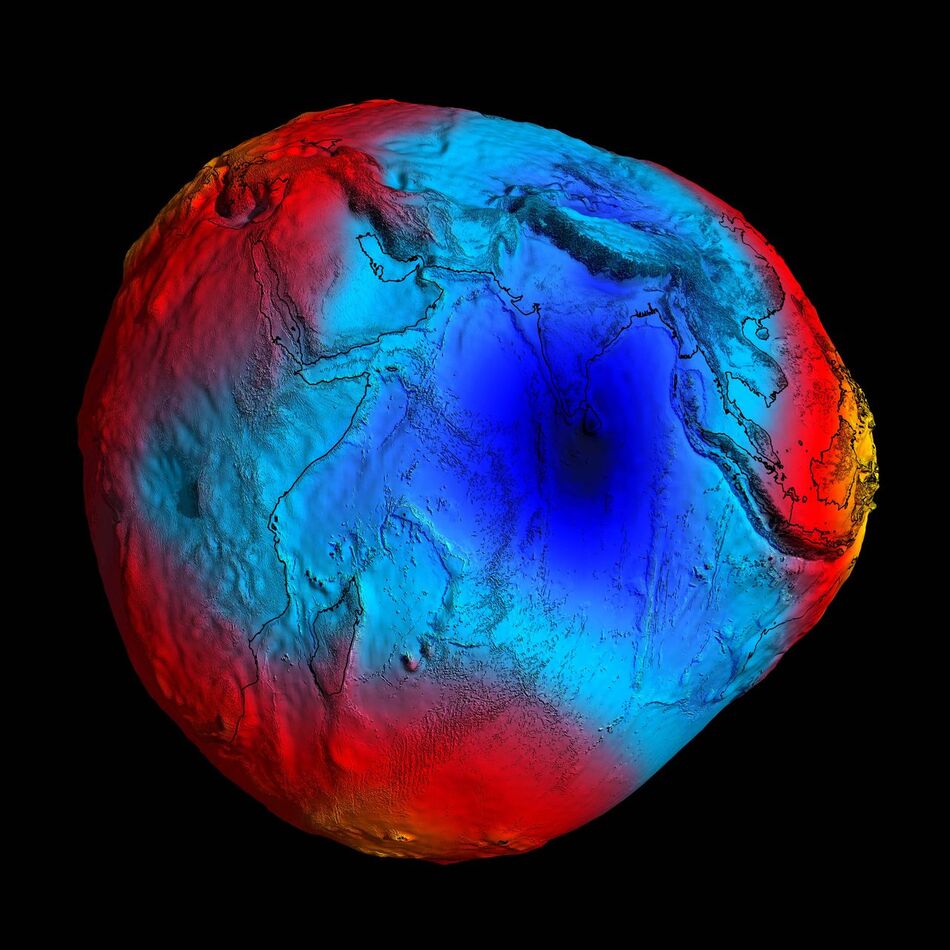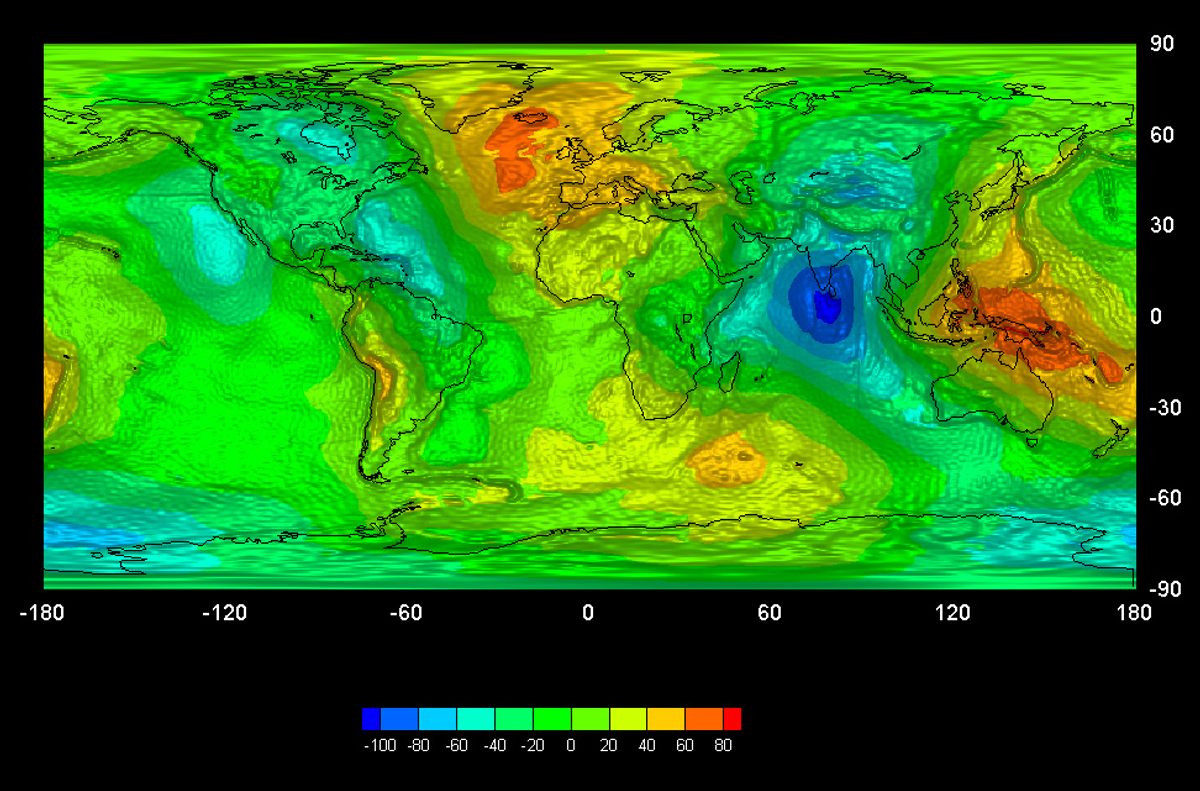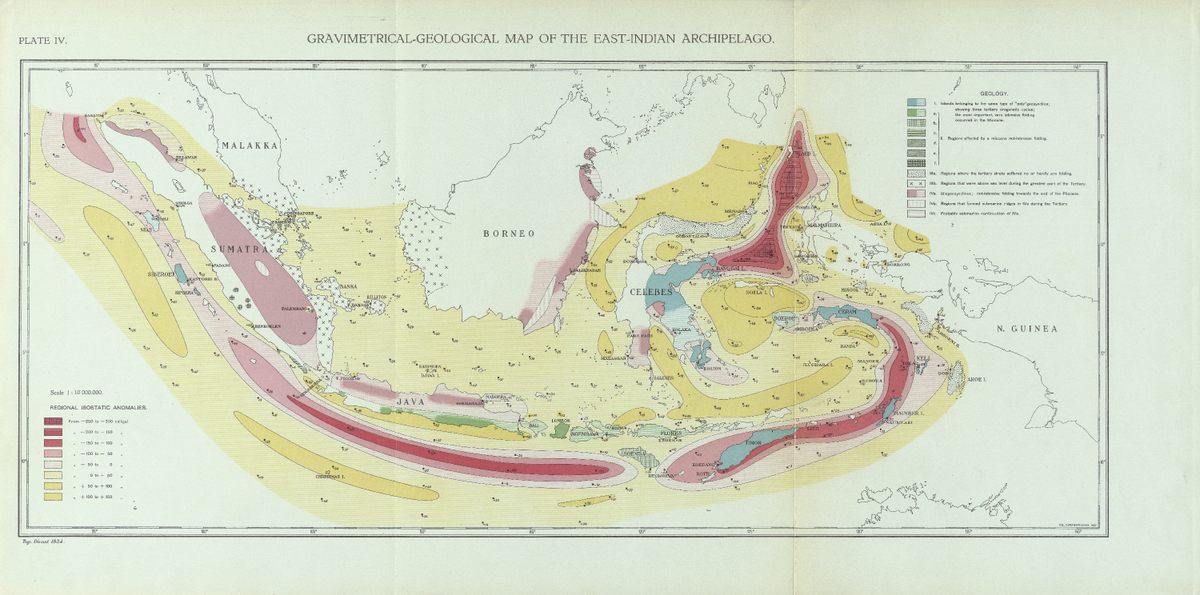The Mystery of the World’s Largest and Deepest Gravity Hole by Frank Jacobs
Nov 9, 2023 15:32:10 #
https://www.atlasobscura.com/articles/gravity-hole-indian-ocean?
Dear Indian Ocean, please don’t take offense, but: Why is your gravity hole so big? That question had been baffling scientists ever since the hole was discovered back in 1948. Now a team from the Indian Institute of Science (IISc) thinks they have found the answer: The “hole” in the Indian Ocean is caused by fragments from the sunken floor of another, much older ocean.
In a mysterious part of the Indian Ocean, the pull of gravity is much weaker than anywhere else on Earth. This gravity hole, the world’s largest (and deepest) gravitational anomaly, is officially known as the Indian Ocean Geoid Low (IOGL). (A geoid is a theoretical model of sea levels worldwide, with its irregularities corresponding to variations in the Earth’s gravity.)
There’s nothing mysterious per se about gravitational variation, which corresponds to differences in the density of the subsurface (and submarine) layers of rock. What was unexplained, was the size and amplitude of the anomaly in the Indian Ocean.
More air than water
The gravity hole is centered about 1,200 kilometers (750 miles) southwest of Kanyakumari (aka Cape Comorin), the southernmost tip of the Indian subcontinent. The circular depression in the ocean has an area of about 3 million square kilometers (1.2 million square miles), which is almost the size of India itself. Due to lower local gravity, the sea level in the IOGL is up to 106 meters (348 feet) lower than the global average. That adds up to a huge volume of air where there should be water. A back of the envelope calculation suggests that, due to the anomaly, about 100 cubic kilometers (25 cubic miles) of water is being displaced.
The anomaly was discovered by Felix Andries Vening Meinesz, a Dutch geophysicist who had invented a device to measure gravity at sea. (It was nicknamed the “Golden Calf,” because of its color and because sailors on submarines carrying the instrument had to remain motionless in their bunk during measurements, a nuisance for which they received extra pay.)
As a pioneer of submarine gravimetry, Vening Meinesz spent much of his career roaming the oceans in submarines and research vessels. He discovered several anomalies in Earth’s gravitational field, which he attributed to plate tectonics, none larger or stronger than the one in the Indian Ocean.
The eminent Dutchman—one of his research fellows was the geologist B.G. Escher, the brother of the graphic artist M.C. Escher—was thinking in the right direction, but his era lacked the computing power to pinpoint a more proximate cause. The actual cause of the IOGL remained unknown until last May, when the journal Geophysical Research Letters published a study by IISc researchers.
Starting the clock 140 million years ago, the IISc team ran various simulations through a supercomputer to explore how tectonic and volcanic forces shaped the world as we know it. The models that produced a gravity hole closely resembling the actual IOGL all had one thing in common: low-density magma plumes rising up to displace higher-density material, weakening the area’s gravity.
How it all went down
Here’s the likely scenario: Around 120 million years ago, the Indian plate broke off from the supercontinent of Gondwana, and went on a collision course with the Eurasian plate. That collision would eventually give rise to the Himalaya mountains. But before it got there, the Indian plate passed over the Tethys plate, closing up the ancient ocean of that name.
The gravity hole in the Indian Ocean is significantly deeper and bigger than any other gravitational anomaly.
The gravity hole in the Indian Ocean is significantly deeper and bigger than any other gravitational anomaly. ESA – GOCE High Level Processing Facility
As fragments of that plate—so-called “Tethyan slabs”—were shoved deeper into Earth’s mantle, they displaced some of the material trapped in what is known as the “African blob,” a continent-sized bubble of magma about 1000 kilometers (600 miles) under East Africa. Some 20 million years ago, that relatively light substance rose toward the surface in plumes.
Together with the mantle structure near the geoid low, those plumes are responsible for the gravitational anomaly off India’s southern tip, the IISc team writes. While the researchers were able to stick an estimate on the age of the geoid low, it’s hard to predict when or if it will ever shift or disappear.
Dear Indian Ocean, please don’t take offense, but: Why is your gravity hole so big? That question had been baffling scientists ever since the hole was discovered back in 1948. Now a team from the Indian Institute of Science (IISc) thinks they have found the answer: The “hole” in the Indian Ocean is caused by fragments from the sunken floor of another, much older ocean.
In a mysterious part of the Indian Ocean, the pull of gravity is much weaker than anywhere else on Earth. This gravity hole, the world’s largest (and deepest) gravitational anomaly, is officially known as the Indian Ocean Geoid Low (IOGL). (A geoid is a theoretical model of sea levels worldwide, with its irregularities corresponding to variations in the Earth’s gravity.)
There’s nothing mysterious per se about gravitational variation, which corresponds to differences in the density of the subsurface (and submarine) layers of rock. What was unexplained, was the size and amplitude of the anomaly in the Indian Ocean.
More air than water
The gravity hole is centered about 1,200 kilometers (750 miles) southwest of Kanyakumari (aka Cape Comorin), the southernmost tip of the Indian subcontinent. The circular depression in the ocean has an area of about 3 million square kilometers (1.2 million square miles), which is almost the size of India itself. Due to lower local gravity, the sea level in the IOGL is up to 106 meters (348 feet) lower than the global average. That adds up to a huge volume of air where there should be water. A back of the envelope calculation suggests that, due to the anomaly, about 100 cubic kilometers (25 cubic miles) of water is being displaced.
The anomaly was discovered by Felix Andries Vening Meinesz, a Dutch geophysicist who had invented a device to measure gravity at sea. (It was nicknamed the “Golden Calf,” because of its color and because sailors on submarines carrying the instrument had to remain motionless in their bunk during measurements, a nuisance for which they received extra pay.)
As a pioneer of submarine gravimetry, Vening Meinesz spent much of his career roaming the oceans in submarines and research vessels. He discovered several anomalies in Earth’s gravitational field, which he attributed to plate tectonics, none larger or stronger than the one in the Indian Ocean.
The eminent Dutchman—one of his research fellows was the geologist B.G. Escher, the brother of the graphic artist M.C. Escher—was thinking in the right direction, but his era lacked the computing power to pinpoint a more proximate cause. The actual cause of the IOGL remained unknown until last May, when the journal Geophysical Research Letters published a study by IISc researchers.
Starting the clock 140 million years ago, the IISc team ran various simulations through a supercomputer to explore how tectonic and volcanic forces shaped the world as we know it. The models that produced a gravity hole closely resembling the actual IOGL all had one thing in common: low-density magma plumes rising up to displace higher-density material, weakening the area’s gravity.
How it all went down
Here’s the likely scenario: Around 120 million years ago, the Indian plate broke off from the supercontinent of Gondwana, and went on a collision course with the Eurasian plate. That collision would eventually give rise to the Himalaya mountains. But before it got there, the Indian plate passed over the Tethys plate, closing up the ancient ocean of that name.
The gravity hole in the Indian Ocean is significantly deeper and bigger than any other gravitational anomaly.
The gravity hole in the Indian Ocean is significantly deeper and bigger than any other gravitational anomaly. ESA – GOCE High Level Processing Facility
As fragments of that plate—so-called “Tethyan slabs”—were shoved deeper into Earth’s mantle, they displaced some of the material trapped in what is known as the “African blob,” a continent-sized bubble of magma about 1000 kilometers (600 miles) under East Africa. Some 20 million years ago, that relatively light substance rose toward the surface in plumes.
Together with the mantle structure near the geoid low, those plumes are responsible for the gravitational anomaly off India’s southern tip, the IISc team writes. While the researchers were able to stick an estimate on the age of the geoid low, it’s hard to predict when or if it will ever shift or disappear.
The piece of sunken ocean is the size of India. ESA/HPF/DLR

Vening Meinesz roamed the ocean in submarines, searching for gravitational anomalies. Utrecht University Archive / Museum, CC BY-SA 3.0

The gravity hole in the Indian Ocean is significantly deeper and bigger than any other gravitational anomaly. ESA – GOCE High Level Processing Facility

Vening Meinesz made this gravimetrical map in 1935. NOAA Central Library Historical Collection / Public domain

Nov 10, 2023 00:14:40 #
Nov 10, 2023 08:00:02 #
MosheR wrote:
So this is where people who need to lose weight should go.
Cheaper to just go to Mexico and drink the water...

Nov 10, 2023 09:53:11 #
MosheR wrote:
So this is where people who need to lose weight should go.


Nov 10, 2023 11:50:25 #
bcheary wrote:
So I imagine the sea level slowly slants toward the center of this depression and if someone was in a boat traveling over that area they would not know they were 348 feet below the mean level of the ocean around that area. It would be like someone observing Death Valley. Even though Death Valley is 282 feet below sea level and the lowest spot in the lower 48, the travel into the desert wouldn't be like standing on a cliff and looking down 282' to the desert floor. For the most part, it would be like a gentle down-sloping drive to the lowest point.
Nov 10, 2023 12:58:21 #
Bridges wrote:
So I imagine the sea level slowly slants toward th... (show quote)
That is something to think about Mike.



Nov 10, 2023 15:26:35 #
For what it's worth, here are my thoughts. I'm thinking the gravity would be stronger. Why? The surface of the ocean floor is lower than the surrounding area, and the sea level is also lower. To me, that would indicate the gravity is much stronger than the surrounding area and ocean floor and surface has been pulled downward due to that higher force. It just seems to me that a lower gravity area would allow the sea level to be higher, not lower.
Now I don't have a submarine from which to take measurements. but think about this. If you are in a Submarine, what are you using to base your measurements on? Depth? If the sea level has changed, how do you know that if you are at a constant depth based on pressure? There is no way that I'm aware of to measure your distance from the center of the earth.
Any other like thoughts out there?
Now I don't have a submarine from which to take measurements. but think about this. If you are in a Submarine, what are you using to base your measurements on? Depth? If the sea level has changed, how do you know that if you are at a constant depth based on pressure? There is no way that I'm aware of to measure your distance from the center of the earth.
Any other like thoughts out there?
Nov 10, 2023 15:46:31 #
RCJets wrote:
For what it's worth, here are my thoughts. I'm thi... (show quote)
Not from me but I am waiting for other opinions and thoughts!



Jan 19, 2024 13:55:00 #
It's been almost nine years since I posted my opinion on this anomaly, and there has been no furthur comments. That leads me to think my opinion makes more sense than the hypothesis given in the original post.
Any other opinions out there?
Any other opinions out there?
Jan 19, 2024 17:38:07 #
RCJets wrote:
It's been almost nine years since I posted my opinion on this anomaly, and there has been no furthur comments. That leads me to think my opinion makes more sense than the hypothesis given in the original post.
Any other opinions out there?
Any other opinions out there?
About gravity, no. However, it may be where the Earth was born -- it's Earth's navel!
Jan 19, 2024 21:56:54 #
RCJets wrote:
It's been almost nine years since I posted my opinion on this anomaly, and there has been no furthur comments. That leads me to think my opinion makes more sense than the hypothesis given in the original post.
Any other opinions out there?
Any other opinions out there?
Just because no one answers...does not equate to a reinforcement of anything.
Jan 20, 2024 09:35:20 #
I don't quite get it. Why does LESS gravity displace water and cause a depression? Am I reading it wrong?
If you want to reply, then register here. Registration is free and your account is created instantly, so you can post right away.




